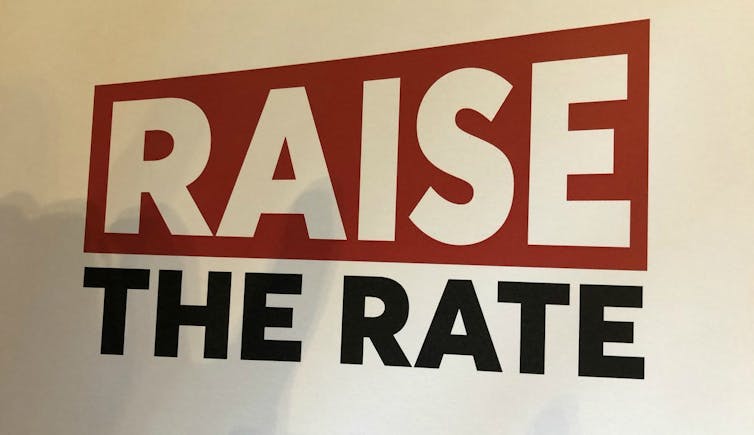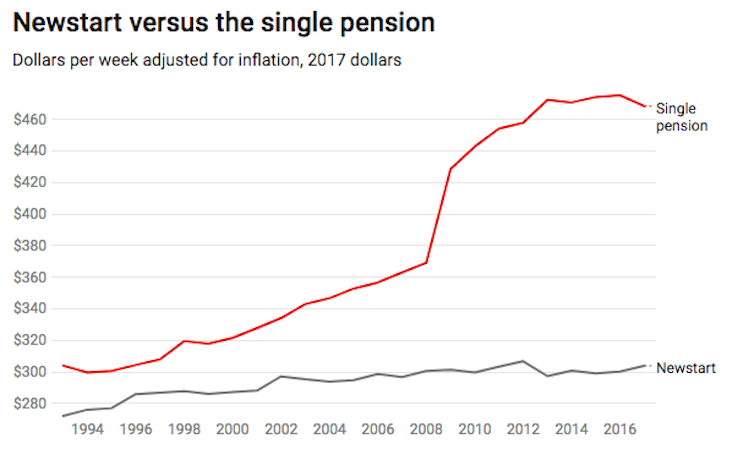 Newstart should be lifted by mush more than usually proposed, a new ANU algorithm finds.Shutterstock
Newstart should be lifted by mush more than usually proposed, a new ANU algorithm finds.ShutterstockIt would be unlikely if our current welfare system gave us the best possible value for the A$120 billion we hand out in benefits each year.
For one thing, we live, work, and arrange families differently to what we did in earlier decades, but the size and nature of the payments has barely changed.
What if we could eliminate more poverty than we do at the moment while spending no more, or what if we could spend less and leave poverty no worse off?
Until now, these have been hard questions to answer.
Read more: Don't believe what they say about inequality. Some of us are worse off
Examining the impact of up to 20 welfare payments and 55 supplementary payments and concessions with multiple withdrawal rates across a range of family types has been time-consuming to near impossible.
At the ANU Centre for Social Research and Methods, we have developed a new algorithm that can calculate it almost instantly.
The first such tool in Australia, we have first used it to work out how to optimise a subset of benefits to get the biggest bang for the bucks.
What matters is the poverty gap
Our target is the poverty gap. The poverty gap is a similar concept to the poverty rate except that it is based not only on whether a household is in poverty, but also how deep in poverty that household is.
The most commonly used standard says a single-person household is in poverty if its income is below about A$450 per week (half the median disposable income).
The less commonly used standard, which we prefer, defines a single-person household as being in poverty if its income is below half the median disposable income net of housing costs, producing a threshold of A$370 per week.
Read more: New evidence suggests we may need to rethink policies aimed at poverty
The poverty gap is the dollar shortfall below these thresholds. A household above them has no poverty gap.
As in real life, our algorithm has a budget constraint. If it didn’t, governments could just give everyone lots of money and there would be no poverty.
It finds that if the aim is to minimise the poverty gap, we need to make quite dramatic changes in how we spend welfare dollars.
We need to raise the rate, big time
To minimise the most commonly used measure of poverty, the Newstart unemployment benefit would have to climb from its current A$551 per fortnight to A$821 – a jump of 50%, and a far bigger hike than the A$150 per fortnight that crossbench Senators are calling for with the backing of the Raise The Rate campaign.
The Age Pension would stay about the same, Family Tax Benefit A for children aged less than 13 years would fall from A$218 per fortnight to A$154, Family Tax Benefit B would fall by a similar proportion, rent assistance would stay about the same, and the parenting payment would fall modestly.
And probably cut the pension
The results are different when we try to minimise poverty as defined by our preferred measure – half of median disposable income, net of housing costs.
To do this, we would have to cut the age pension from A$902 per fortnight to A$836, lift Newstart less substantially to A$751 per fortnight (still an increase of around A$100 per week, and still more than crossbenchers are asking for), lift rent assistance from a maximum rate of A$137 per fortnight to A$161, and leave family payments about where they are.
We could cut poverty by 11%, at no cost
The algorithm suggests that reductions in the poverty gap of as much as 11% could be achieved simply by spending more on Newstart and less on other benefits, without any extra spending on the overall bundle of payments.
Alternatively, we could cut our spending on the bundle by about 7% and leave the poverty gap no worse. Lifting the budget for the bundle could lead to even larger reductions in poverty.
A 10% increase in the budget those benefits could reduce poverty by more than 20%.
 The Council of Social Service supports an increase of $150 a fortnight. It should probably be bigger.ACOSS
The Council of Social Service supports an increase of $150 a fortnight. It should probably be bigger.ACOSSBut there is more to benefits than poverty
There are arguably sound reasons why we pay more to people on long-term benefits such as the pension than to people on short-term benefits such as Newstart, meaning that poverty reduction isn’t the system’s only goal.
However, it should be noted that the difference in indexation arrangements between the two benefits has pushed down Newstart from about 90% of the age pension in the early 1990s to just 60% today, meaning Newstart is highly likely to be genuinely out of whack, whatever the system’s objectives.
 ACOSS
ACOSSAlso, our analysis finds that many households in apparent poverty are not on benefits, and so can’t be helped by changes to the bundle of payments.
On the other hand, while some of these households are legitimately in poverty, others are asset-rich. Around 56% of the apparent gap in poverty resides in households whose main source of income is something such as shares, rental income or superanuation, suggesting they might not need as much help as our algorithm suggests.
We believe our new methodology is an Australian first.
It provides a very efficient means of deriving optimal social security payment settings from a variety of policy objectives.
We expect to broaden it to more policy objectives in the future and to a broader range of payments and elements of the social security system, and to include personal income tax.
Read more: New budget standards show just how inadequate the Newstart Allowance has become
Our method is in its infancy.
We have provided one illustration of how it can be used, and the results are striking: the best way to cut poverty when constrained by a budget is to boost Newstart while pushing down either the pension or family benefits by a modest amount.
Ben Phillips receives funding from the Australian Research Council and has receive funding from a broad range of government and non-government organisations.
Matthew Gray has received funding for many Commonwealth, State and Territory governments and a range of other organisations.
Richard Webster does not work for, consult, own shares in or receive funding from any company or organisation that would benefit from this article, and has disclosed no relevant affiliations beyond their academic appointment.
Authors: Ben Phillips, Associate Professor, Centre for Social Research and Methods, Director, Centre for Economic Policy Research (CEPR), Australian National University
| < Prev | Next > |
|---|







